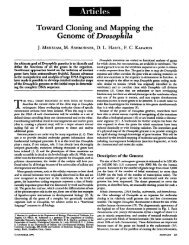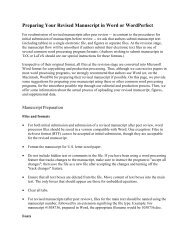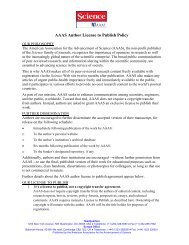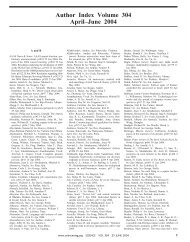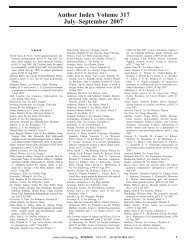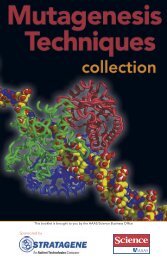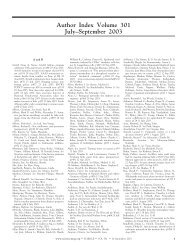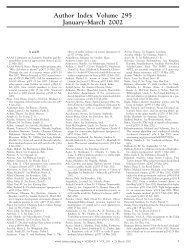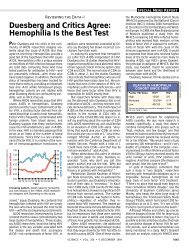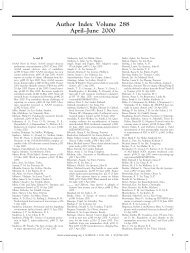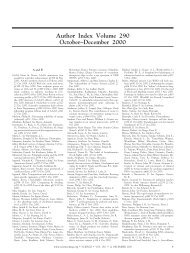Chinese Academy of Sciences (PDF) - low res version
Chinese Academy of Sciences (PDF) - low res version
Chinese Academy of Sciences (PDF) - low res version
You also want an ePaper? Increase the reach of your titles
YUMPU automatically turns print PDFs into web optimized ePapers that Google loves.
36<br />
CAS/In Focus<br />
Wu Fuyuan Yuan Yaxiang<br />
Yang Xueming<br />
“For CAS<br />
institutes and<br />
universities,<br />
returnees like<br />
Yang rep<strong>res</strong>ent<br />
a young,<br />
energetic talent<br />
pool with strong<br />
credentials.”<br />
Zhou Zhonghe<br />
Editorial News Report:<br />
Attracting Top Talent<br />
A<br />
key factor in the revitalization<br />
<strong>of</strong> <strong>Chinese</strong> <strong>Academy</strong> <strong>of</strong> <strong>Sciences</strong><br />
(CAS) <strong>res</strong>earch under<br />
the Knowledge Innovation<br />
Program, or KIP was the push to recruit<br />
internationally competitive talent to CAS<br />
institutes (see page 43). “There are a few<br />
factors that are very important in doing science;<br />
the most important is the talent,” says<br />
Yang Xueming, director <strong>of</strong> the State Key<br />
Laboratory <strong>of</strong> Molecular Reaction Dynamics<br />
at the Dalian Institute <strong>of</strong> Physics. Yang<br />
himself earned his Ph.D. at the University<br />
<strong>of</strong> California, Santa Barbara and worked at<br />
institutions in the United States and Taiwan<br />
before returning to the mainland in 2001.<br />
There he designs and builds instruments to<br />
investigate chemical reactions, particularly<br />
those that occur on the surfaces <strong>of</strong> materials<br />
or in the gas phase.<br />
For CAS institutes and universities, returnees<br />
like Yang (known as haigui, or sea<br />
turtles) rep<strong>res</strong>ent a young, energetic talent<br />
pool with strong credentials. With their<br />
foreign language skills and international<br />
networks, they have been a major driver in<br />
opening up China’s <strong>res</strong>earch by publishing<br />
in international journals and forging collaborations<br />
with colleagues overseas. “We are<br />
trying to create an international atmosphere<br />
for doing <strong>res</strong>earch” and ensure that China’s<br />
<strong>res</strong>earchers are internationally competitive,<br />
says Lü Yonglong, director-general <strong>of</strong><br />
the Bureau <strong>of</strong> International Cooperation at<br />
CAS.<br />
The emphasis on recruitment is also an<br />
effort to make up for lost time. Higher education<br />
and most <strong>res</strong>earch activities stopped<br />
Zhou Qi<br />
Talent and Education<br />
for a decade during the Cultural Revolution, and in the '80s and '90s, the<br />
overwhelming majority <strong>of</strong> China’s top graduates in science went abroad,<br />
never to return. As Zhou Zhonghe, director <strong>of</strong> the Institute <strong>of</strong> Vertebrate<br />
Paleontology and Paleoanthropology (IVPP) in Beijing, says, “Why would<br />
they come back? The salaries were miserable.”<br />
Recruitment Programs<br />
CAS’s ability to attract young, foreign-trained scientists comes in part from<br />
special talent-recruitment programs aimed at this cohort. One <strong>of</strong> the earliest<br />
<strong>of</strong> these, the Hundred Talents Program, started in 1994 with the aim <strong>of</strong><br />
recruiting hundreds <strong>of</strong> outstanding new hi<strong>res</strong> domestically and abroad by<br />
the end <strong>of</strong> the century. Applicants who passed the competitive selection<br />
process received generous startup funding for their laboratories and other<br />
benefits. The program continues today; it now provides eligible new hi<strong>res</strong><br />
with nearly half a million U.S. dollars in startup funds for their first three<br />
years <strong>of</strong> <strong>res</strong>earch. More than 2,000 <strong>res</strong>earchers have benefited from the<br />
program so far, most <strong>of</strong> whom have overseas experience.<br />
One <strong>of</strong> them, Wu Fuyuan, spent a year as a visiting scholar at the University<br />
<strong>of</strong> Rennes 1 in France, and later left a faculty position in Shandong<br />
Province’s Jining University in 2003 to join CAS’s Institute <strong>of</strong> Geology and<br />
Geophysics. “At that time it wasn’t easy for the younger generation to get<br />
<strong>res</strong>earch grants,” he recalls. “The Hundred Talents Program provided 2 million<br />
yuan [about US$240,000 at the time], so that was a big grant for a<br />
young scientist.” Wu is now the deputy director <strong>of</strong> his institute, and last year<br />
won the TWAS Prize for Earth <strong>Sciences</strong>. In hindsight, “I think my choice<br />
was the right one,” Wu says, citing the institute’s good facilities, access<br />
to funding opportunities, and freedom from teaching duties. And joining<br />
CAS has afforded him unique <strong>res</strong>earch opportunities, he says. “In universities,<br />
<strong>res</strong>earch is organized by individual pr<strong>of</strong>essors, but the <strong>Academy</strong> really<br />
focuses on important problems in science or in the development <strong>of</strong> the<br />
country,” organizing teams around high-priority <strong>res</strong>earch projects, he says.<br />
Wu is part <strong>of</strong> a large collaboration that since 2006 has studied the North<br />
China Craton, a large section <strong>of</strong> the earth’s crust that spans parts <strong>of</strong> China,<br />
Mongolia, and Korea.<br />
A more recent Hundred Talents recipient, Liu Lingli, earned a Ph.D. at<br />
North Carolina State University and did a postdoc with the US Environmental<br />
Protection Agency before taking a faculty position at the Institute <strong>of</strong><br />
Botany (IB-CAS) late last year. The startup package she received through<br />
CREDIT: PHOTOS BY RICKY WONG



